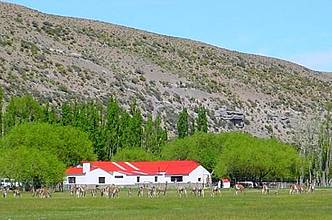A Tour Throughout Río Mayo
Uncrowded but windy streets and warm people invite us to learn about the secret of their lives. Each corner keeps traces of love for their ancestors and values treasured throughout the years.
As we arrived in Río Mayo, our first impression was of an uninhabited town. We watched dull streets and our car was enveloped by the dust of its gravel streets. Although stores seemed to be unconnected with each other, while visiting we discovered some hotels and coffee stores where to stay for a while and grasp the essence of this windy Patagonian town. As we had a chat with some inhabitants, our first impression changed. On the outskirts are cattle farms generating jobs and the town center, for many people, is considered only as a stop. We accepted the idea of cycling around the town. We noticed that both young and older people used this popular means of transport. We started our biking tour at the site where the traditional National Shearing Festival takes place during three days in the month of January and sheep breeders, shearing workers and their families enjoy it.
Year after year more and more Argentinians from every corner of our country and foreigners attend the gaucho parades, the display of hand-knitted items and, particularly, the shearing contest in which both men and women take part. On those days, musical concerts with local as well as renowned Argentinian artists, bonfires with asado and traditional dishes change the appearance of this town. We left this site and took the coastal road of Río Mayo. This river runs downhill and its watercourse is constantly changing. It carries a great volume of water during the meltdown season and floods are usual. One of them destroyed the Puente Viejo (Old Bridge) and its remains pay tribute to this mandatory passage for cart drivers. In summer, people from Río Mayo visit the river resort to bathe and cool down from high temperatures. As we wandered around, we smelled a mint scent from the low vegetation all around. We learned from Leandro Gigena, our guide, that this river offers spots full of trouts and salmons only a few kilometers away, which attract a great number of fishing enthusiasts every year. Again, we headed for the downtown area and we realized that the buildings were low and featuring large backyards. Leandro made reference to the lack of pollution and spoiling of landscape. Tracing the Old Rio Mayo We arrived at the spacious San Martin Square and left the bikes for a few minutes to watch an unusual attraction: a stream and its small pond called Menuco dividing the park into two sections. The waters of that stream used to be the meeting point for old cart drivers who needed to have a rest along with their horses in the old days, but no so long ago. A cart with huge wheels was left as a souvenir of those days. How many roads have these drivers carrying load driven! Leandro said: “Fifteen Criollo horses used to pull this cart and carry the wool to Sarmiento, from where the train left to the port of Comodoro Rivadavia”. The Town Hall, the Town Council and the library buildings are situated opposite the main square. During our tour, we watched another monument carefully, which was difficult to understand. It was two open hands holding a fleece, a symbol of the hard shearing work. The Criollo horse was also represented by a sculpture on this spot. The A'Ayones Park (“wetlands”, in the Tehuelche tongue) has a water fountain and a huge mural painted by a local artist. We found a group of young people playing the guitar, which is somehow usual here due to the lack of a shopping mall or a cinema. In the heart of downtown, we found two campsites: the one next to the Culture House has a stream and a stage, where there are crowded musical shows in summer. We visited the handicraft and dance workshops offered by the municipality. We talked with a teacher and we noticed how appealing these workshops were among the locals. People from Río Mayo show how proud they are of the municipal gym, and football field, which are open to the community, since sport plays a main role within this town. We would visit the viewpoint by car at any other time. Located over the cliff, we could see the town from a high point and a winding river running among ravines. It was midday and while our thoughts were running through our morning tour, we stared at the almost empty streets. Nap time was a sacred time, which, we thought, also defined a lifestyle. Our biking tour was not a coincidence. We accepted such invitation and, with a simple gesture, we showed our gratitude for the silence and tranquility reigning at this place.
Mónica Pons
Eduardo Epifanio





















